A perfect illustration in today’s Seattle Times — and yes, I still read newspapers on dead trees, four a day in fact — how our economy operates today at warp speed. On Page 1, news that in response to competitive pressure from Airbus, Boeing will be cutting costs and trimming [continue reading . . . ]
I can’t help but think what’s going on in global markets seems like a re-run of what happened in the fall of 2008, when Lehman Brothers failed, banks had to be bailed out and the worst recession since the Great Depression ensued. AP business writer Alex Veiga neatly sums up [continue reading . . . ]
Who would have guessed that incomes are more unequal in Communist China than in the United States? Not me. A new report from Peking University, cited in the Financial Times, says the richest 1% of China’s households own a third of the country’s wealth. The poorest 25% own just 1%. [continue reading . . . ]

Population of the Evergreen State has grown about 60% faster than the national average in first half of the decade. Only seven states have grown at a faster rate; only two of those seven have more population than Washington. International migration — people moving from other countries — accounts for [continue reading . . . ]
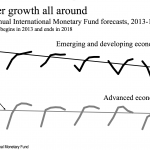
Raising interest rates a quarter point as the Fed did this week does not change the fact that we live in a slow-growth world. Money markets and commodities markets are singing the same song in unison: Almost no inflation, and very little growth. To say that commodities prices have collapsed [continue reading . . . ]
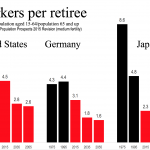
Worried about your Social Security benefits? You ought to be. Whether you are in your 70s or your 20s , the number of workers taxed to support you in our pay-as-you-go social-insurance system are or will be fewer than supported your parents and grandparents. We’re living longer and having fewer [continue reading . . . ]
Don’t miss the essay in the Wall Street Journal on Sept. 19, 2015 by Dr. Bjørn Lomborg, the Danish author and environmentalist, featuring what I regard as uncommon sense on climate change. No Wall Street Journal subscription? If you have a library card in your purse or wallet, you can [continue reading . . . ]
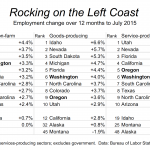
Employment has been growing faster than average in the recent past on the West Coast generally and in the Pacific Northwest states in particular. Among the states I follow as a regional economist, Montana and Alaska, both hit hard by the collapse of oil prices, rank well below aveage. The [continue reading . . . ]
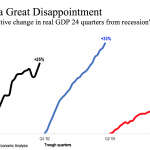
Good on us that the U.S. economy grew at an annual rate estimated at 3.7% in the April-May-June quarter rather than the 2.2% rate announced as the first estimate a month ago. But don’t get too excited. State and local government spending accounted for a higher-than-average share of the growth [continue reading . . . ]
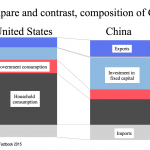
One of the main problems with China’s economy is that it is geared too heavily to exports and infrastructure spending, too little to domestic consumption. You can see the contrast with the U.S. in the chart. American consumers are in the driver’s seat in the U.S. Household consumption in 2014 [continue reading . . . ]
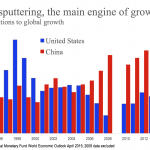
Two decades ago China’s economy was roughly a quarter the size of the U.S. economy. Today the economies are of roughly equal size, each producing about $17.5 trillion worth of goods and services based on an economic concept known as purchasing power parity (PPP). The concept discounts the effects of [continue reading . . . ]

If you haven’t read it, get to your library (or use your library card) to read Ruchir Sharma’s op-ed in the Wall Street Journal August 17 (Page A 11). He argues that with advanced economies stuck in slow-growth mode, the globe is “one shock away from recession” and that the [continue reading . . . ]